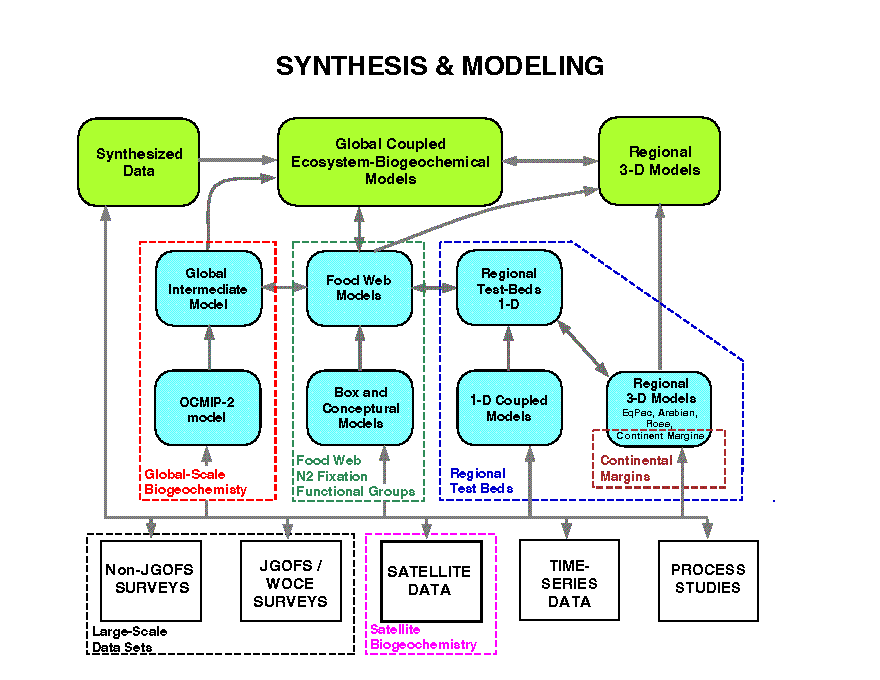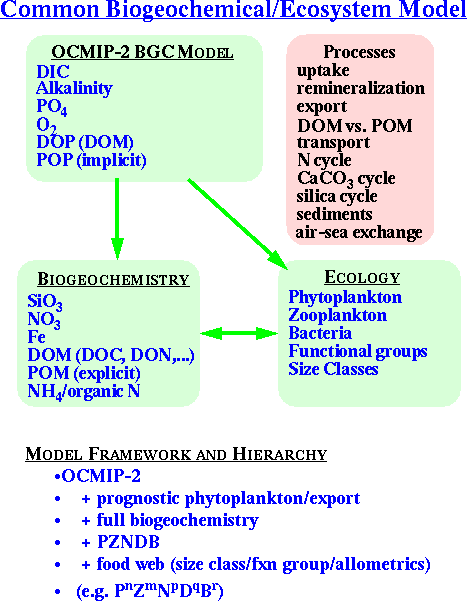
Meeting Overview
Scott C. Doney and Joanie A. Kleypas, NCAR
Introduction
The second annual Principal Investigator meeting of the U.S. JGOFS Synthesis and Modeling Project (SMP) was held this past July at Keystone, Colorado. The 1999 expansion of the SMP (through both NOAA/DOE and NSF funding) essentially doubled the number of SMP projects, which was obvious from the more than seventy participants in attendance. To accommodate the growing size of the program, the SMP summer workshop of previous years was transformed into the annual PI meeting. The main goals of the meeting were to:
Working groups
The working groups are a key element in the SMP strategy to promote
collaboration and the overall synthesis of the JGOFS results. Given
the emphasis then of this year's meeting on maximizing cooperation across
projects and disciplines, most of the agenda was slated for working group
meetings. Initially, SMP researchers approached the meetings with
a critical eye toward combining, splitting, or creating new working groups.
In the end, the original seven working groups were maintained, and a new
one, a "Food Web" group, was created based on the need to better understand
and model the role of various food webs in biogeochemical processes.
The current SMP working groups and chairs are:
| Satellite Biogeochemistry | Mary-Elena Carr |
| Large-scale Data Sets | Chris Sabine and Ralph Keeling |
| Food Webs | Hugh Ducklow, Mike Roman, and Ed Laws |
| Community Synthesis | Mick Follows and Scott Doney |
| N2 Fixation | Doug Capone and Raleigh Hood |
| Regional Test-beds | Rob Armstrong |
| Global Biogeochemical Modeling | Ray Najjar and Ed Laws |
| Continental Margins | Frank Muller-Karger and Don Redalje |
Figure 1 illustrates in a schematic fashion the relationships among the JGOFS field data and the various SMP projects and working groups, leading at the end of the program to a set of improved regional and global coupled ecosystem-biogeochemical models and the original and synthetic data sets required for model evaluation.
Working groups were instructed to address four major issues:
Several working groups suggested writing a synthesis paper as an appropriate focal point, enabling the PIs to review in detail the current status and future directions for their topic. For example, the Satellite Biogeochemistry working group suggested a "reverse engineering" approach; that is, to develop regional empirical relationships, which can then be extrapolated in space and time between the current suite of remotely sensed data products (e.g. ocean color, SST, winds, altimetry) and key observed biogeochemical processes (e.g. primary and export production; functional group distributions etc.). The synthesis paper would also be followed by a section with suggestions toward future sensor development.assemble regional food web compartment and flow data for each JGOFS process study examine the current suite of standard biogeochemical parameterizations (e.g. remineralization; nitrogen fixation) (with Global BGC group) develop criteria for minimum necessary food web model complexity
Community activities
A number of broader community activities also have been initiated within the SMP, and a set of short plenary discussions on specific topics were held daily at the PI meeting. Several issues were resolved from the open discussions, including:
Special Journal Issue. The plans for a series of SMP special issues in Deep-Sea Research Part II are being finalized. The submission date for papers would be approximately mid-April, 2000, and papers will be solicited on the general topic of: "The synthesis and modeling of ocean biogeochemistry with respect to the ocean carbon cycle and the controls on ocean-atmosphere carbon partitioning", with Scott Doney, Jorge Sarmiento and perhaps one additional SMP PI serving as guest editors. During the discussion at the PI meeting a suggestion arose for a separate "fast turn around time" special issue for synthesis papers, but on reflection it was felt to be more efficient to combine all available SMP manuscripts (individual project results; working group synthesis papers) into a single volume. The proposal is to have a following, second SMP special issue with a deadline 1-1½ years later.
SMP Model-Data Management. The goals of the SMP data management effort are to:
Communication and the SMP web page. The SMP is searching continually for new and innovative vehicles for communicating the results of the program, internally within the program, with the broad scientific community and with the public. The SMP web page (http://usjgofs.whoi.edu/mzweb/syn-mod.htm) has been considerably revamped, providing more background on the program, updates on progress, and links to individual SMP projects (we hope to have active links to ALL SMP projects in the not too distant future). A preprint/reprint site for SMP results has been implemented, and we are discussing the idea of a "SMP Picture Gallery" to reach a more general audience. The Community Modeling and Synthesis working group is assisting with many of these issues.
A Core Biogeochemistry-Ecosystem Model. The concept of encapsulating the findings of JGOFS in the form of numerical models has been a stated goal from the inception of the overall program. One proposed element as part of the "grand synthesis" of SMP would be a "core biogeochemical model" implemented globally in a 3-D circulation model. The objective would not be to promote a single model that could address all scientific questions, as such a model is a fictional chimera at best. Rather the SMP could develop a base-line global biogeochemical model of manageable complexity and computational demand but that incorporates the emerging new understanding from JGOFS and the SMP. The model would move beyond the current generation of very simple biogeochemical models as exhibited by the OCMIP-2 biotic model by incorporating multiple nutrient limitation (N, P, Fe) and major geochemically relevant processes for carbon (N, CaCO3, and silica cycling). A hierarchical approach is envisioned, and a schematic developed by the Biogeochemical Modeling working group is shown in Figure 2.
Recent SMP science highlights
Although the SMP PIs have only been funded for at most a year and a half by the time of the Keystone meeting, a considerable number of exciting results are already emerging. This was highlighted at the meeting by the 5-minute project overviews, which also proved to be quite valuable in facilitating collaboration among investigators across the broad array of SMP projects. Each PI was asked to briefly describe their project in terms of the scientific objectives, the technical approach (e.g. data synthesis, numerical model), and the potential contributions to the overall SMP goals. The condensed nature of the talks, followed up by posters, enabled attendees to determine the overlaps and natural linkages among all of the projects. More details on emerging findings from individual SMP projects can be found through links from the SMP home page (http://www1.whoi.edu/mzweb/smp_people.html).
Several theme talks centered around SMP progress to date were presented, and included an update on the following:
"Global CO2 Survey": Dick Feely and Chris Sabine discussed progress on the synthesis and archiving of the carbon related parameters from the U.S. JGOFS/WOCE Global CO2 Survey. The analysis is being done basin by basin, with the Indian Ocean complete and the Pacific well underway. Based on intercomparisons at section cross-over points and comparisons with CRMs (certified reference materials), corrections are applied to different sections to create internally consistent dissolved inorganic carbon and alkalinity data sets. Gridded basin-wide products of both observed concentrations and derived quantities (e.g. anthropogenic CO2) will also be produced. The analysis of the global survey is being coordinated through the Large-Scale Data Set Working Group and early results are available through the CDIAC Global Ocean Data Analysis Project site (http://cdiac.esd.ornl.gov/cdiac/oceans/glodap/index.html).
"Biogeochemical Processes in the Equatorial Pacific Ocean": Dick Dugdale (with Dick Barber) and Chuck McClain presented new information derived from their SMP projects on the Equatorial Pacific. Dugdale presented evidence for periods of silica regulation of new and export primary productivity in the equatorial Pacific, with shifts between diatom and picoplankton dominated systems. McClain focused on SeaWiFS observations, with an overview of the global data set and events in the tropical Pacific, Atlantic, and Indian Oceans during the first 18 months of the mission. His talk highlighted the genesis and evolution of the extensive phytoplankton bloom (values of about 1.0 mg Chl m-3 compared to prior background levels of 0.05-0.1 mg Chl m-3) during the 1998 transition from El Niño to La Niña conditions.
"Bermuda Mesoscale Regional Test Bed": Dennis McGillicuddy presented initial results from his eddy-resolving regional physical-biological model for the Bermuda region. The model is driven at the edges of the domain by satellite altimeter data, and the predicted time evolution of sea surface height anomaly for the model interior was compared with an objectively analyzed satellite data product. The regional model appears to capture much of the mesoscale variability about the Bermuda site. Dennis offered these simulations as a possible test-bed for other SMP model developments.
"The HBE Index and Mixing in GCMs": Niki Gruber and Anand Gnanadesikan discussed the sensitivity of ocean-atmosphere CO2 partitioning to mixing in the main thermocline and the assumption that atmospheric CO2 is controlled by high-latitude processes ("polar dominance"). Gruber presented the background on the HBE (Harvardton-Bear) Index, a measure the importance of the warm surface layer. Recent results suggest a dichotomy between box models (low HBE, polar dominated) and some GCM results (moderate HBE, mix of subtropical and polar). Gnanadesikan discussed how increasing diapycnal thermocline mixing in a GCM tends to increase the HBE index. He demonstrated how the observed pycnocline depth can be produced either with large amounts of lateral and vertical mixing or with essentially no vertical mixing and moderate levels of lateral mixing. These two extremes have very different patterns of biogeochemical cycling, and he noted that JGOFS results (mostly based on silica cycle) tend to favor the second picture.
"Progress in Food Web Dynamics": Ed Laws and Rob Armstrong presented new results and views on food web models. Laws discussed application of a pelagic food web model formulated to better quantify the partitioning of production between microbial and larger phytoplankton pathways and the subsequent effect on export production. His results suggest that most of the variance in ef ratios (new prod/total prod = export prod/total prod), is explained by temperature, rather than by total production. Combining the ef ratio model with estimates of ocean temperature and photosynthetic rates derived from satellite data indicates that export production on a global scale is about 20% of net photosynthesis. Rob Armstrong presented an alternative way of looking at food webs where grazing and higher trophic interactions are treated parametrically.
Meeting Summary
Keystone, which is a fairly isolated mountain resort, offered not only
a respite from the heat that had captured much of the US this summer, but
also spectacular views and a quiet peaceful setting. The environment
was informal and comfortable, and may have been the right touch that resulted
in the high degree of interaction and cooperation between investigators.
It was realized that the SMP of US JGOFS must approach its objectives differently
than the field projects on which it is based. Because these goals
require extensive crossover between many different disciplines, the tremendous
opportunity to discover new and exciting information in the ocean carbon
cycle will only be met with a high degree of Project-Project interaction
and information exchange. The summer PI meeting obviously established
many such lines of communication.
